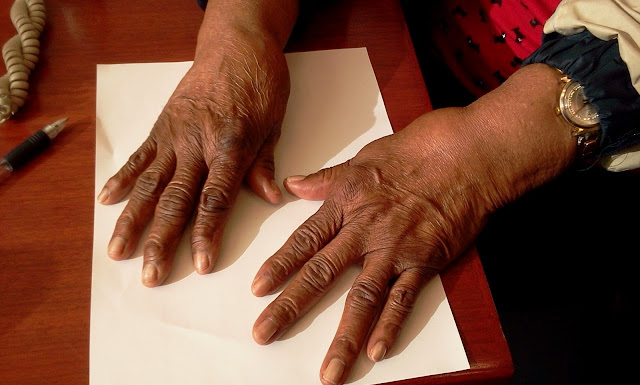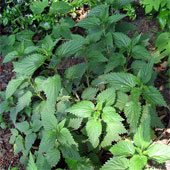December 25th, 2011 by Toni Brayer, M.D. in Health Tips
5 Comments »


Severe osteoarthritis of the hands
One of my patients came to see me today with severe right knee pain. This is not a new problem, and in fact, we have been dealing with flare ups of her osteoarthritis for years. It mainly affects her knees and hands and today her right knee was swollen and felt like the “bone was rubbing together” with each step. She could hardly walk because of the pain.
Osteoarthritis is also known as degenerative arthritis and it is one of the most common maladies of aging joints, affecting millions of people. The cartilage in joints wears down and inflammation causes the bones to build up spurs and small micro tears. It affects women more than men and the cause is unknown. There are likely genetic factors as it tends to run in families. Arthritis can occur in any joint but the most common are the fingers, wrists, hips, neck and spine and knees. Stiffness (especially in the morning) and pain are the main symptoms that limit mobility.
You can see Read more »
*This blog post was originally published at EverythingHealth*
November 25th, 2011 by ChristopherChangMD in Health Tips
No Comments »

A deviated septum is a well known factor causing nasal obstruction in people. However, many patients with a deviated septum will also state that there are times when they can breathe just fine from their nose. As such, can a deviated septum truly be the cause of their nasal obstructive symptoms? Shouldn’t the obstruction be constant?
The blunt answer is ABSOLUTELY nasal obstruction can be intermittent OR constant with a deviated septum!!! It’s more a question of degree.
To begin with, a deviated septum is when the wall that separates the right and left nasal cavities is bent one way (green arrow in left illustration) instead of being perfectly straight (right illustration).

 If there is no mucosal swelling, a person with a deviated septum is able to breathe from both sides just fine. However, if there is the slightest bit of mucosal swelling from turbinate hypertrophy, allergies, upper respiratory infection, or any other environmental irritation, the side that is more narrow will obstruct much more readily with less swelling given there is just “less room” for swelling to occur before obstruction occurs.
If there is no mucosal swelling, a person with a deviated septum is able to breathe from both sides just fine. However, if there is the slightest bit of mucosal swelling from turbinate hypertrophy, allergies, upper respiratory infection, or any other environmental irritation, the side that is more narrow will obstruct much more readily with less swelling given there is just “less room” for swelling to occur before obstruction occurs.
Below is the same exact nose and septum as above, but with mucosal swelling present. Read more »
*This blog post was originally published at Fauquier ENT Blog*
November 14th, 2011 by Paul Auerbach, M.D. in Research
No Comments »


Stinging nettle plants, courtesy of Dezidor (CC BY 3.0)
Hikers often brush up against injurious plants, such as poison oak or thorny shrubs. One particularly vexing plant is the “ubiquitous weed, Urtica dioica,” commonly known as stinging nettles. As described in an article entitled “Mechanism of Action of Stinging Nettles” (Wilderness & Environmental Medicine:22,136-139,2011) by Alexander Cummings and Michael Olsen, direct contact exposure to the weed causes immediate stinging and burning sensation on the skin. The authors exposed mouse skin to the plants and looked at this skin using an electron microscope. They found smooth nettle spicules that had pierced the skin surface, a few of which retained their bases, which appeared empty of liquid contents. The authors concluded that the mechanism of action of stinging nettles skin reaction was both biochemical and mechanical, likely caused by impalement of spicules into the skin.
The spicules are present as small “hairs” that are found on the stem and undersides of the leaves of the plant. Even light touch against the plant can cause a reaction, which is often characterized as Read more »
This post, The Burning, Itching, And Swelling Of Stinging Nettles: Removing Them From The Skin, was originally published on
Healthine.com by Paul Auerbach, M.D..
November 6th, 2011 by ChristopherChangMD in Health Tips
1 Comment »

 Though most people like the professional nose whistler shown here require an instrument to enable the nose to whistle, in others it occurs naturally due to unique anatomic features within the nose.
Though most people like the professional nose whistler shown here require an instrument to enable the nose to whistle, in others it occurs naturally due to unique anatomic features within the nose.
Why might someone’s nose whistle?
Septal Perforation
 The most common reason it may occur constantly is due to a hole in the septum (septal perforation). The septum is a wall that divides the right nasal cavity from the left side. Normally, it should be straight and without any openings.
The most common reason it may occur constantly is due to a hole in the septum (septal perforation). The septum is a wall that divides the right nasal cavity from the left side. Normally, it should be straight and without any openings.
However, when a hole is present in the septum and it is in just the right size and place, whenever air is breathed in and out of the nose, it will whistle. In this situation, the hole is the “window” of the whistle and the nose itself is the mouthpiece.
Correction of this problem is by Read more »
*This blog post was originally published at Fauquier ENT Blog*
November 6th, 2011 by Toni Brayer, M.D. in Health Tips
No Comments »


Immediately Post-op Carpal Tunnel release
Carpal Tunnel Syndrome (CTS) is common and is the result of the median nerve becoming squeezed or “entrapped” as it passes through the wrist down into the palm of the hand. Because this is a sensory nerve, the compression causes tingling, burning and itching numbness in the palm of the hand and fingers. A different nerve goes to the little finger and the lateral half of the 4th finger so the sensation there would feel normal. There is often a sensation of swelling even though there is rarely any true edema that can be seen in CTS.
The symptoms of Carpal Tunnel Syndrome usually start at night when people sleep with flexed wrists. As it progresses, the tingling and numbness can be felt on and off during the day. It can cause decreased grip strength and weakness in the hands.
CTS can be worsened by medical conditions like rheumatoid arthritis, diabetes, pregnancy or wrist trauma. Women are three times more likely to develop CTS than men, and it is rare in children. Most of the time no cause is found. The space that the median nerve traverses is very tiny and it doesn’t take much to compress the nerve. Even small amounts of tissue swelling such as occurs in pregnancy can cause severe symptoms.
The treatment for Carpal Tunnel Syndrome starts with Read more »
*This blog post was originally published at EverythingHealth*




















